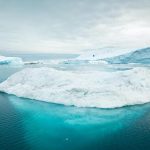Rain fell for several hours at Greenland’s summit for the first time on record. Let’s take a closer look at what happened and how unprecedented it is.
Greenland’s Rain Just Broke A New Record
For the first time since the 1950s, when records started being registered, rain fell on the top of the Greenland glacier cap, approximately 3000 meters above sea level.
The National Snow and Ice Data Center (NSIDC) reveals that in mid-August (on the 14th) the temperature at the summit of Greenland was above 0ºC for the third time in less than a decade. Some areas were even 18º C warmer than the average temperature, reaching 1º C in some places.
This increase in temperature helped create an extreme rain phenomenon which intermittently caused seven billion tons of water to fall onto the ice sheet for 13 hours.
“Basically, it rained all day [on Saturday]. It was raining every hour while the team was doing weather observations,” Zoe Courville, a research engineer at the Cold Region Research and Research Laboratory, told The Washington Post. “It is the first time this has been observed,” she added.
Raining on Greeland in Not a New Phenomenon
A heatwave in Greenland, with temperatures more than 10ºC above normal for the time, caused an episode of melting of the Greenland ice cap in late July, glaciologists warned.
Back then unusual temperatures of more than 20ºC were recorded in northern Greenland, according to the Danish meteorological institute DMI.
This heatwave, which also affected a large part of the vast Arctic territory, resulted in an accelerated rate of melting of the ice cap.
Greenland’s daily melt record – which was recorded in the summer of 2019 and poured 197 billion tons of water into the North Atlantic – has not been broken. Nonetheless, the part of Greenlandic territory where the ice has recently melted is larger than that which melted two years ago.
Since it is the second-largest glacier cap after Antarctica, with an area of nearly 1.8 million square kilometers, the ice sheet covering Greenland is a matter of concern for scientists as Arctic warming is three times faster than in other parts of the world (see video below to learn why).
The shrinking of the Greenland ice cap began several decades ago, accelerated since 1990, and continues in this dynamic. A recent study from the University of Liege says the melting of the Greenlandic ice cap alone is likely to contribute to an overall rise in sea level by 10 to 18 centimeters by 2100, which is 60% faster than previous estimates. A scenario the IPCC’s recent report points out for melting to be even more intense: an issue well covered in an article on The Conversation.
Due to a relatively cold early summer with snow and rain, the shrinking of the ice cap this year is still within the historical average for the moment, according to the Polar Portal which says that the melting period extends from June to the beginning of September.
Ice Melting Is Enhancing A Dangerous Feedback Loop
What’s worrying is that melting in Greenland threatens to significantly boycott humanity’s efforts to mitigate climate change. That’s because, after a certain point, it may create catastrophic “feedback loops”.
On the one hand, rainfall leaves ice sheets more prone to surface melting since it intensifies the so-called “ice-albedo positive feedback”. In other words, the melting reinforces itself.
When rain falls, its warmth can melt snow, exposing the underlying darker ice, which absorbs more sunlight, increases surface temperature, and leads to further melting.
Unfortunately, this isn’t the only positive feedback loop destabilizing the Greenland ice sheet.
There’s another “positive” feedback loop where the lower height of the ice sheet leads to faster melting because higher temperatures occur at lower altitudes.
Plus, when higher temperatures cause coastal glaciers to thin, there’s more ice falling into the ocean, rushing the rate of glacier flow towards the sea and lowering the ice surface, exposing it to warmer air temperatures which will lead to further melting.
If all of Greenland’s ice melts, the sea level would rise around 6-7 meters (despite it taking centuries or even millennia to happen). Still, the billions of metric tonnes of ice that have been melting in Greenland since the 90s are making the sea level rise and putting coastal cities all around the globe at risk.
If we are to prevent the melting of ice sheets (and permafrost), tackling and mitigating climate change is definitely the way forwards – while there is still time.
[Photo by Alexander Hafemann on Unsplash]

